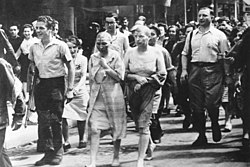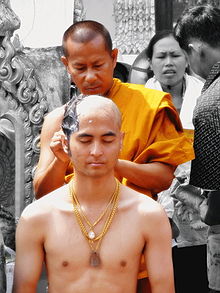Head shaving
It has been suggested that Bald females be merged into this article. (Discuss) Proposed since February 2014. |
Head shaving is the practice of shaving the hair from a person's head. At different times and places people have shaved, all or part of, their heads for very diverse reasons: practical, religious, cultural, or aesthetic—so a shaven head has widely varying connotations depending on the context.
Early history

The earliest historical records describing head shaving originated in ancient Mediterranean cultures, such as Egypt, Greece, and Rome. The Egyptian priest class ritualistically removed all body hair by plucking. This included hair on the head, eyebrows, and beard.
Contexts
Military
The practice of shaving heads has been used in the military. Although sometimes explained as being for hygiene reasons, the image of strict, disciplined conformity may certainly be a factor. During the allied invasion of Normandy on D-Day, many soldiers chose to have their heads completely shaved, denying the defending Germans something to grab onto when the battle moved to close quarters. For the new recruit, it can be a rite of passage, and variations become a badge of honour (see jarhead).
The militaries of the United States, Russia, and several other countries have welcomed their recruits by giving them haircuts using hair clippers with no guard attached. As of 2011, shaved heads continued to be standard haircuts in the United States Air Force, United States Marine Corps, United States Army, and the United States Coast Guard during basic/recruit training - upon graduation from training, grooming restrictions are relaxed in accordance with each service's regulations. In Greece, this practice was abolished on June 25, 1982, when the military started allowing recruits to have up to 4 cm of hair. Before then, the regulation haircut in the Greek army for recruits was en hro (an archaic phrase for "shaved to the bone").
A shaved head continues to be common place in the United States military. There have been traditions spawned from shaving a service members head. Most notable is the tradition of shaving one's head when a service member enters the Mediterranean Sea by ship for the first time, known as "Med Head"[citation needed].
Prison and punishment

Prisoners commonly have their heads shaven, often ostensibly to prevent the spread of lice, but may also be used as a demeaning measure.
Having the head shaved can be a punishment prescribed in law,[2] but also something done as "mob justice" - a stark example of which was the thousands of European women who had their heads shaved in front of cheering crowds in the wake of World War II,[3][4][5] as punishment for associating with occupying Nazis during the war.
Religious

Many Buddhists, Hajj pilgrims and Vaisnavas, especially members of the Hare Krishna movement, shave their heads.
Some Hindu and most Buddhist monks and nuns shave their heads upon entering their order, and Korean Buddhist monks and nuns have their heads shaved every 15 days.[6]
Muslims shave their head when performing Umrah.
Class
Throughout much of the 20th century in many Western countries, head shaving was considered somewhat unusual or lower class. Head shaving was often associated with manual workers such as seamen, dock workers and soldiers, as well as with prisoners and hospital patients.
Sport
Competitive swimmers will often shave their entire body, including the head, to reduce drag while swimming.
Baldness
People with alopecia often choose to shave their heads to hide the effects. Those with Alopecia areata and men facing male pattern baldness may choose to shave fully. Michael Jordan, Mark Messier, Andre Agassi, Kerry King of Slayer, Rob Halford of Judas Priest, Billy Corgan of the Smashing Pumpkins, Phil Selway of Radiohead, Michael Stipe of R.E.M., Chris Daughtry of Daughtry (band), theoretical physicist Kip Thorne, and actors Bruce Willis and Mark Strong are famous examples. Also, there are examples of bald females.
Skinhead and other subcultures
In the 1960s, some British working class youths developed the skinhead subculture, whose members were distinguished by short cropped hair (although at that time they didn't shave their heads right down to the scalp). This look was partly influenced by the Jamaican rude boy style.[7][8] It was not until the skinhead revival in the late 1970s — with the appearance of punk rock-influenced Oi! skinheads — that many skinheads started shaving their hair right down to the scalp. Head shaving has also appeared in other youth-oriented subcultures which include punk, hardcore, metalcore, Nu metal, hip hop, techno music, and neo-nazi scenes.
Sexuality, gender and LGBT
A sexual fetish involving erotic head shaving is called a trichophilia. While a shaved head on a man relates to virility, a shaved head on a woman typically connotes androgyny, especially when combined with traditionally feminine signifiers. It may well express membership in the bisexual, lesbian and genderqueer communities. Similarly, gay men sometimes incorporate a shaven head into their overall look. Specifically, the stereotypical "Castro clone" look commonly shave their heads in order to project a homoerotic ultra-masculine image. Drag queens have sometimes adopted shaven heads, again, to express a genderqueer image. In the BDSM community, shaving a submissive or slave's head is often used to demonstrate powerlessness, or submission to the will of a dominant.
Fundraising and support
In solidarity with cancer sufferers, some people chose to shave their heads – particularly as part of fund-raising efforts. (Baldness is a well-known side-effect of the chemotherapy often used to treat cancer, and some people shave their heads before undergoing such treatment.)
Fiction
In modern settings, shaved heads are often associated with characters who display a stern and disciplined or hardcore attitude. Examples include Yul Brynner and Vin Diesel, and Samuel L. Jackson in roles such as Mace Windu and Nick Fury. Goatee beards are often worn to complement the look or add sophistication. For most of the AMC series Breaking Bad, actor Bryan Cranston wore a goatee along with a clean shaven head, contributing to the iconic image of Heisenberg.[9] In futuristic settings, shaved heads are often associated with bland uniformity, especially in sterile futuristic settings such as THX 1138 (1971).[10] In Fritz Lang's early science fiction film Metropolis (1927), hundreds of extras had their heads shaved to represent the oppressed masses of a future dystopia.
See also
|
|
References
- Notes
- ^ DeMello, Margo (2012). Faces Around the World: A Cultural Encyclopedia of the Human Face. ABC-CLIO. p. 135. ISBN 15-98846-17-5.
For instance, beginning in the Middle Ages, European women of means shaved, pumiced, or plucked their eyebrows, and often shaved some of their hairline as well, in order to achieve the beauty standard of a wide, high forehead.
{{cite book}}: Cite has empty unknown parameter:|chapterurl=(help) - ^ "Article 87 ... shall be sentenced to flogging, having his head shaven, and one year of exile...", The Islamic Penal Code of the Islamic Republic of Iran
- ^ "Shaved Heads and Marked Bodies: Representations From Cultures of Trauma" Kristine Stiles, Duke University (1993) Duke.edu
- ^ "An Ugly Carnival", The Guardian
- ^ "Shorn Women: Gender and Punishment in Liberation France", ISBN 978-1-85973-584-8
- ^ Geraldine A. Larkin, First You Shave Your Head, Celestial Arts (2001), ISBN 1-58761-009-4
- ^ Old Skool Jim. Trojan Skinhead Reggae Box Set liner notes. London: Trojan Records. TJETD169.
- ^ Marshall, George (1991). Spirit of '69 - A Skinhead Bible. S.T. Publishing.
- ^ Stahl, Jeremy (2013-9-27). "Gateway Episodes: Breaking Bad". Slate.
{{cite web}}: Check date values in:|date=(help) - ^ "THX 1138". The New York Times.
